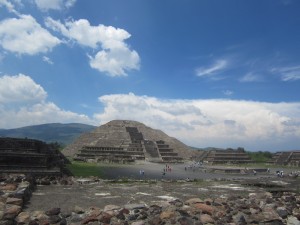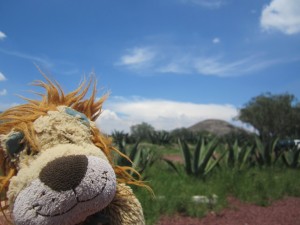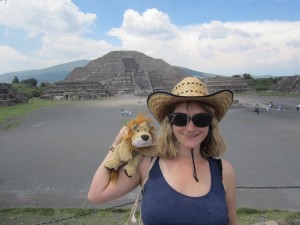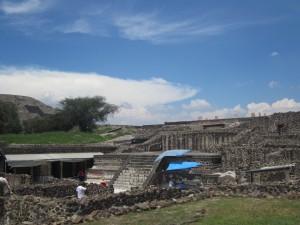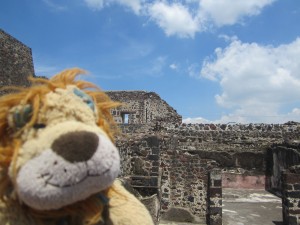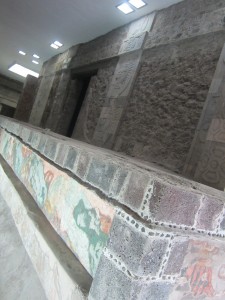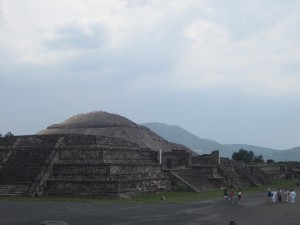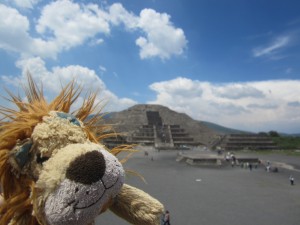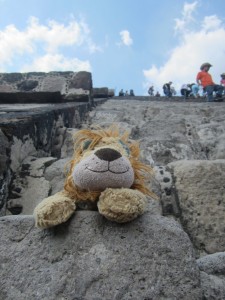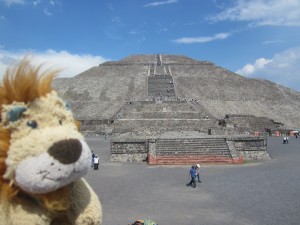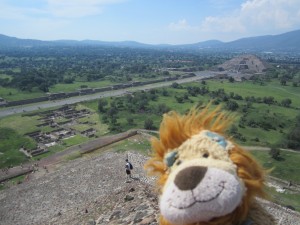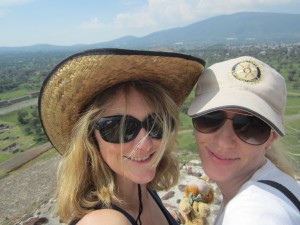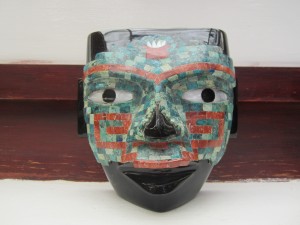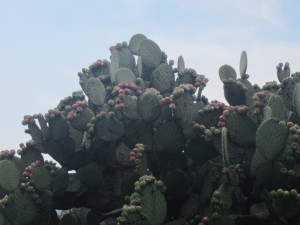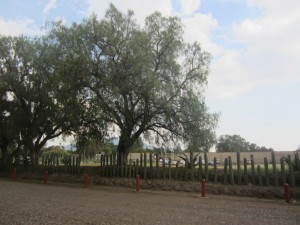The site where the Teotihuacan Pyramids stand is sometimes called the ‘City of the Gods’ and it is one of the biggest and most important cities of ancient Mexico. It lies not far outside of Mexico City and Lewis the Lion was excited to be visiting this World Heritage site. Before Lewis the Lion got there he had mistakenly believed that this site was from the Aztec period but he was wrong. It was in fact much older than that by about fifteen hundred years! He was eager to learn more…
The entrance to the site for an adult is 57MXP (the same as many other archeological sites across Mexico).
Can you work out how much that would roughly be in pounds and pence using one of Lewis’ last blogs to help you?
Even from a distance, these pyramids looked huge and Lewis the Lion could hardly believe that they still existed at all. So far on his travels to Mexico City, he had learnt that when the Spanish came to conquer that they tore many of the native buildings down and used the bricks to rebuild their own Spanish style buildings so it was a wonder why they hadn’t destroyed this place too? Lewis wondered why? One thing is for certain though, it was an incredibly hot day and the shop owners selling souvenirs were making a killing on selling sun hats. Helen didn’t mind though as she only paid 20 pesos for a rather smart looking cowboy hat!
The visit to this archeological site started with an introduction to the town. Lewis the Lion couldn’t believe how advanced it was considering that its construction was started in 200 BC. It even had a sewerage and drainage system. It was in fact one of the first planned cities in Mesoamerica with two main avenues dividing up the site. At its height, it is thought to have had a population of about 175,000 inhabitants!
Due to the way they often built layers upon layers of buildings, Lewis was surprised to find that a temple still had bright paintwork and intricate designs. That was because they had been protected from the sun and it was wonderful to think that these had been created more than two thousand years ago.
As Lewis the Lion wandered into the main street, the Avenue of the Dead, he marvelled at the two main pyramids: the Pyramid of the Moon and the Pyramid of the Sun. However, right along the avenue there were other buildings that also looked like temples, as well as mounds of grass that were probably still hiding other temples or pyramids, just waiting to excavated. Excavation on the site had only been going on in the last century or so and the archeologists still had many unanswered questions. In particular, they still didn’t know exactly who lived here as the site was abandoned some time between 700 and 750 AD. Perhaps this had something to do with the fact that the Spanish didn’t destroy it: either they didn’t know it existed or they knew that it didn’t have any significant value by the 16th Century?
What Lewis the Lion found fascinating was that whoever had built this city was very clever as the pyramids even reflected the landscape around them. You can see in this picture how the pyramid mirrors the line of the hillside.
He also discovered that the Pyramid of the Moon at the top of the avenue, was exactly 20 metres less than the Pyramid of the Sun (which rose to approximately 64 metres). These architects were obviously clever mathematicians too!
As Lewis the Lion approached the steps to the Pyramid of the Moon, he realised just how steep the stairs were to climb to the top. He climbed up a few but under the hot sun, he decided with Helen and their friend Susan, to save his energy for the walk to the top of the Pyramid of the Sun where he would be able to get an even better view.
So, the three friends headed for the main pyramid, the Pyramid to the Sun. He discovered that it originally would have had a temple at the top of it, dedicated to their sun god. However, what surprised him was that unlike the Egyptian pyramids, these pyramids were solid in construction. He did think it was incredible that from the Americas to Africa, these ancient cultures had the same idea of building pyramid structures to worship their gods: what a coincidence!
The walk to the top of the Pyramid of the Sun was physically demanding as the steps were very steep in parts. There was a policeman making sure that the tourists climbed to the top safely, holding on to the rope like banister as they went. Lewis the Lion thought that the policeman would have to be very fit to climb this everyday!
At the top of the pyramid there was an incredible view, looking down at the Avenue of the Dead to the Moon pyramid. Lewis the Lion imagined that there might have been processions through this sacred street from one Pyramid to another, perhaps? And if this was the case, how many people would have been involved? Would there have been music? What sort of clothes might they have worn? Would there have been human sacrifices like the Aztecs used to do? So many questions that he might never find the answers to!
However, one certainty was that he had to hang on to Helen’s hand tightly with his little paw, whilst she had to hold on tightly to her hat with the other one, as it was very windy indeed at the top of this pyramid!
Looking down on the avenue, Lewis the Lion could see many artisanal sellers trying to engage the tourists with their wares. ‘It’s so cheap, it’s practically free!’ he heard them calling out. They were trying to sell all sorts of things from silver jewellery, lace and embroidered pictures, traditional obsidian masks (like the ones you can see in the photos below) and images of the Aztec calendars. He could also hear many people blowing special whistles that sounded like animals growling. At first Lewis the Lion laughed as it made unsuspecting passers-by jump out of their skin but after he’s seen them do it about a million times, he started to get a bit bored of it.
One thing that he did appreciate though as he walked through this extraordinary place, was the cactus plants. This one in particular brought back happy memories of eating the cactus fruit (tuna in Spanish!) on the streets of Arequipa in Peru.
He also thought that this special tall and thin, spiked cactus was being used in an ingenious way: it was being used as a fence! ‘What a great way to use a plant instead of barbed wire or an electric fence,’ Lewis the Lion thought to himself.
As in so many times on Lewis the Lion’s worldwide adventures so far, he felt like he had learnt so much but that he now had more questions than answers! Who used to live there? How were they educated as they were clearly very smart? How did they worship? Why did they abandon such an impressive city? Did something bad happen or was there something better elsewhere? And so on.
What questions would you like to ask about the impressive Teotihuacan site?
Maybe you could find out more about the archeologists’ work by clicking on this link?

